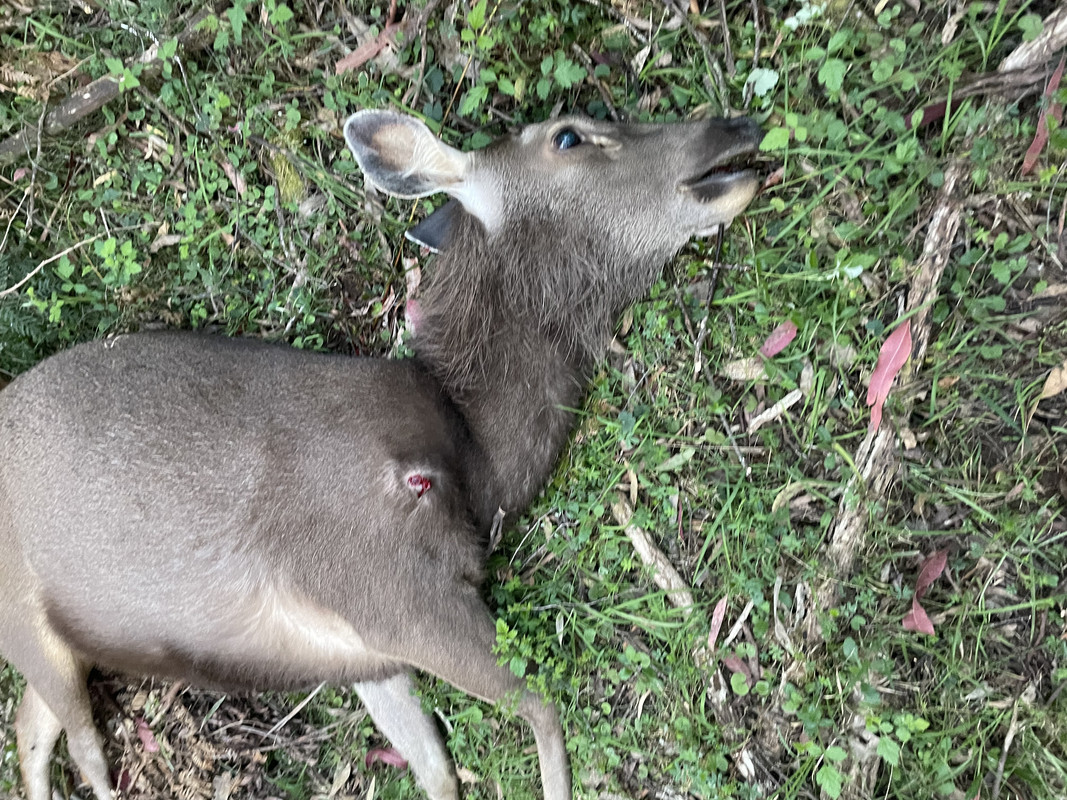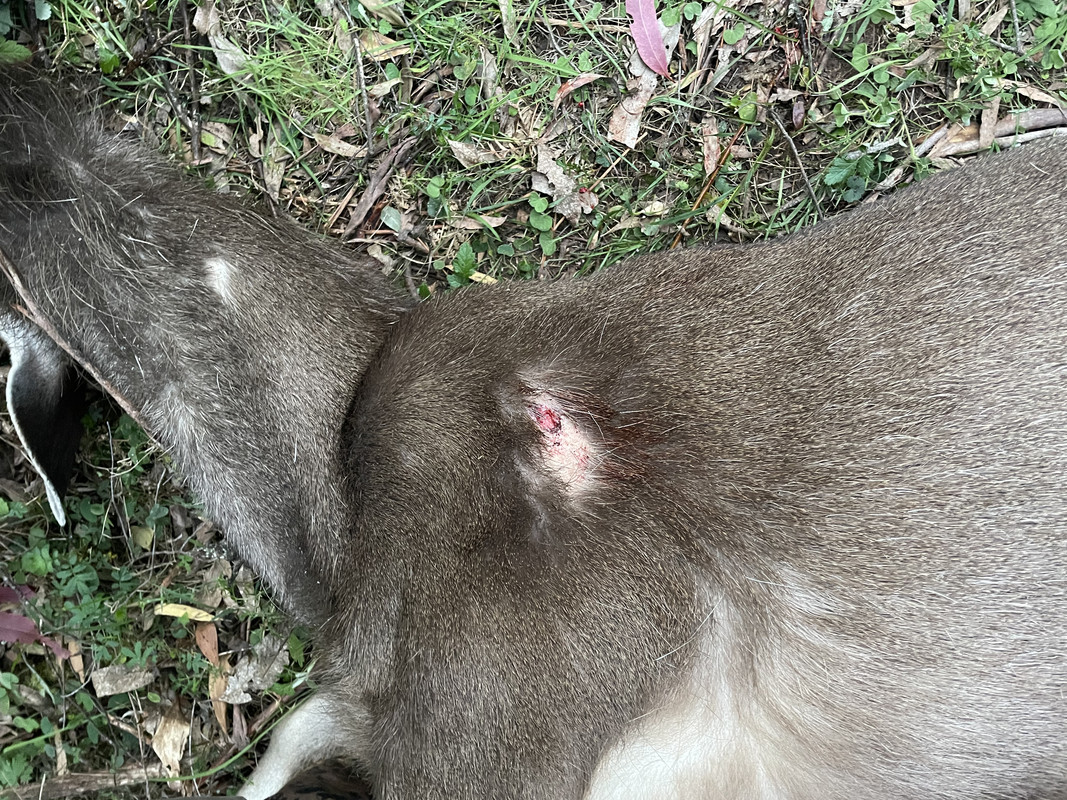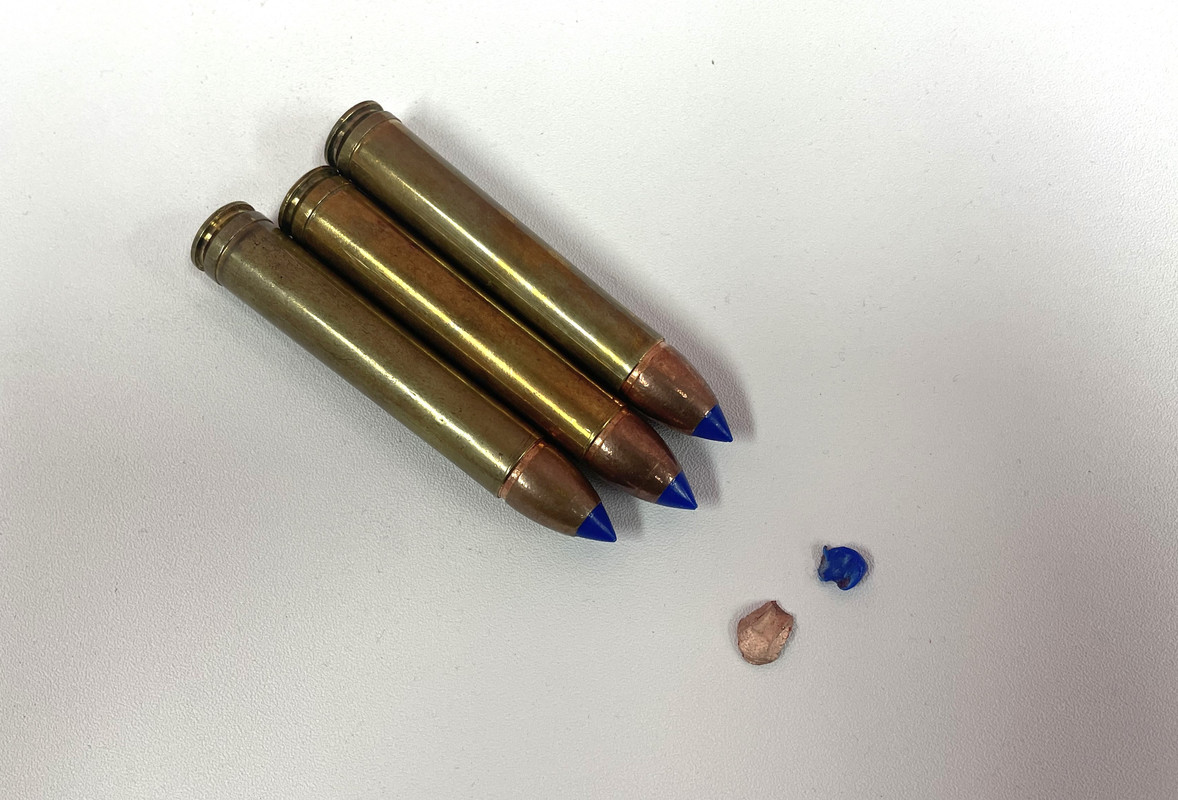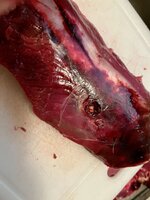I don't have a picture, but I might be able to dig through a freezer to find the scapula...this is a story of an unknown but too small bullet for a long range shot with Barnes ttsx. We harvested a bear last spring (2024) that had a slight limp. When I deboned the scapula, I was surprised to see a weird scar/heal mark on the scapula and a blue tip in the joint just below. The bullet damaged but clearly didn't penetrate the scapula. We never found that bullet. ADFG had a report of a hunter wounded bear in 2023 to a similar size/color bear that was not recovered (too far of a shot). I wish I knew how far the 2023 shot was and the caliber, but something happened to that bullet.
Navigation
Install the app
How to install the app on iOS
Follow along with the video below to see how to install our site as a web app on your home screen.
Note: This feature may not be available in some browsers.
More options
Style variation
You are using an out of date browser. It may not display this or other websites correctly.
You should upgrade or use an alternative browser.
You should upgrade or use an alternative browser.
.223, 6mm, and 6.5 failures on big game
- Thread starter Dave0317
- Start date
I don't understand it either, that's exactly why I asked the question. I've listened to Form/S2H/Backcoutnry etc. podcasts, I understand how they work in tissue and that what seems to have happened.. can't. But it did. So my question was how? First thing I asked him was "is there ANY possible way the bullet hit something in flight, branch, weed, anything", he said "absolutely zero, he was in the middle of a mainline, maybe a bird or a bumblebee?". I don't have any experience with low impact velocity testing, so I don't know if that's what a squib load would look like. But squib load or suicide grouse are the only plausible possibilities I can fathom.I’m not in the small caliber camp, but I gotta say I am scratching my head how that situation could have physically occurred. There was a mass of a bullet left (vs it somehow truly blowing up) that somehow was stopped in a very short distance against tissue and thin bone, I don’t understand what the mechanism of failure could have been. A explosive bullet at full speed would destroy more tissue and have less retained mass right? Would a squib load going slow have deformed that much?
I'll be a son of a.. Solid work detective!!@Harvey_NW I think I have the mystery figured out! This buck had been shot before but that bullet was stopped by the impenetrable shoulder of a blacktail deer. Your friend just happened to make the perfect shot, which hit that bullet and tear open a nasty wound while ricocheting off into the woods where it got stuck in an old growth log. That bullet will be found by the next generation of loggers and be the story for the ages of the bullet that stopped the resaw line.
Case closed!
Jay
Swamp Fox
WKR
- Joined
- Oct 20, 2022
- Messages
- 1,085
Never have lost a ML deer. .50 cal ... mostly from my TC Renegade ... Old skool ... Short shots, open sights ...Muzzleloaders SUCK but I still love a muzzy hunt every year.
Like anything else, don't stretch something 'til it won't work.
Last edited:
Leaf Litter
WKR
- Joined
- Sep 8, 2022
- Messages
- 310
On game:
2 failures to penetrate deer thoracic cavities, both 223 shooting 64gr deer season XP. 110 and 25 yards, respectively. Both quartering towards and hit the front shoulder. Both bullets exploded upon impact and destroyed the scapula and soft tissue but never penetrated into the body cavity. Both deer died eventually, but only after long tracking jobs and multiple followup shots. If there hadn't been snow on the ground, neither would have been found.
On top of that, I watched a couple 108 ELD-M bullets explode in MID AIR at matches. If they can't penetrate air reliably, I'm not hunting with them.
2 failures to penetrate deer thoracic cavities, both 223 shooting 64gr deer season XP. 110 and 25 yards, respectively. Both quartering towards and hit the front shoulder. Both bullets exploded upon impact and destroyed the scapula and soft tissue but never penetrated into the body cavity. Both deer died eventually, but only after long tracking jobs and multiple followup shots. If there hadn't been snow on the ground, neither would have been found.
On top of that, I watched a couple 108 ELD-M bullets explode in MID AIR at matches. If they can't penetrate air reliably, I'm not hunting with them.
rifletuner
WKR
- Joined
- Dec 23, 2020
- Messages
- 493
Just for reference on calibres re blood trails. Last year my son was hunting sambar deer in northern Victoria (Australia) with his new 458 Win mag. We developed a load for his rifle using the 300 grain Barnes TTSX BT bullets made for the 458 SOCOM. In the 458 socom, this bullet would have a muzzle velocity of maybe 1900FPS, but in his 458 it is leaving the muzzle at around 2400fps.
He shot a sambar hind (female) deer at 40-50 yards with this rifle. The deer dropped at the shot, struggled, then regained its feet before running approximately 20 yards and expiring. We went to the spot where it had been hit, with no blood visible, then followed its trail as best as we could. But we found no blood at all. The shot on the deer was with it standing broadside but angled slightly facing towards him. The bullet entered at the front of the shoulder and exited the off side shoulder. During butchering we found several of the petals broken off inside the deer, but the 45 cal shank of the bullet had fully penetrated the deer.
So great penetration with a 45 cal hole in and out, but no blood at all. I think if you asked most people would you expect a blood trail after shooting a deer with a 300gn bullet from a 458, they would pretty unanimously reply "yes".
Photos of the entry, exit and one of the recovered petals and the bullet tip:



He shot a sambar hind (female) deer at 40-50 yards with this rifle. The deer dropped at the shot, struggled, then regained its feet before running approximately 20 yards and expiring. We went to the spot where it had been hit, with no blood visible, then followed its trail as best as we could. But we found no blood at all. The shot on the deer was with it standing broadside but angled slightly facing towards him. The bullet entered at the front of the shoulder and exited the off side shoulder. During butchering we found several of the petals broken off inside the deer, but the 45 cal shank of the bullet had fully penetrated the deer.
So great penetration with a 45 cal hole in and out, but no blood at all. I think if you asked most people would you expect a blood trail after shooting a deer with a 300gn bullet from a 458, they would pretty unanimously reply "yes".
Photos of the entry, exit and one of the recovered petals and the bullet tip:



prairieboy
FNG
Last year i loaded up the 77 gr tmk for a friend who uses the 223 for deer. (My wife has used 223 for deer as well) In the past we have used 55 gr hornady sp or sierra 55 gr(1365) with good success, they exit lung shot deer 60% of the time and do good damage and if they dont exit there is a nice mushroom.
They shot 5 or 6 deer with the 77 gr tmk, all under 100 yards. 1 exit. Runners were hard to find, they didn't go much past 50 yards but most had little to no blood. I thought they were soft, never anything but shrapnel recovered, but they didn't look too hard.
I've put a 200 gr sst from a smokeless muzzleloader into a whitetail doe broadside lung shot at 110 yards. Muzzle velocity was 2300 fps, impact about 1950. Good rest. I heard it hit i'm pretty sure. the load has little recoil, i'm pretty sure i saw it hit as well. Shot was 10 min before dark, so most searching was in the dark. I saw her run down a quad trail for 50 yards, she went out of my sight after that. 2 of us looked for an hour, no blood, no hair at impact sight, no nothing. Hard to call it a bullet failure without a recovered animal. Checked gun next day, perfect.
They shot 5 or 6 deer with the 77 gr tmk, all under 100 yards. 1 exit. Runners were hard to find, they didn't go much past 50 yards but most had little to no blood. I thought they were soft, never anything but shrapnel recovered, but they didn't look too hard.
I've put a 200 gr sst from a smokeless muzzleloader into a whitetail doe broadside lung shot at 110 yards. Muzzle velocity was 2300 fps, impact about 1950. Good rest. I heard it hit i'm pretty sure. the load has little recoil, i'm pretty sure i saw it hit as well. Shot was 10 min before dark, so most searching was in the dark. I saw her run down a quad trail for 50 yards, she went out of my sight after that. 2 of us looked for an hour, no blood, no hair at impact sight, no nothing. Hard to call it a bullet failure without a recovered animal. Checked gun next day, perfect.
Bullets coming apart in flight, generally speaking, is a twist rate vs muzzle velocity issue of too many RPMs and also exacerbated by bore condition (rough bore damaging the jacket and then over spinning). It’s something to keep in mind regardless of caliber.On top of that, I watched a couple 108 ELD-M bullets explode in MID AIR at matches. If they can't penetrate air reliably, I'm not hunting with them.
Leaf Litter
WKR
- Joined
- Sep 8, 2022
- Messages
- 310
The 6mm ELD-M is notorious for coming apart in flight. It's a bullet issue, not a twist issue.Bullets coming apart in flight, generally speaking, is a twist rate vs muzzle velocity issue of too many RPMs and also exacerbated by bore condition (rough bore damaging the jacket and then over spinning). It’s something to keep in mind regardless of caliber.
If a bullet requires a fast twist rate to stabilize, but that twist rate destroys the bullet, it's a garbage design.
HandgunHTR
WKR
- Joined
- Jan 27, 2022
- Messages
- 2,035
The 6mm ELD-M is notorious for coming apart in flight. It's a bullet issue, not a twist issue.
If a bullet requires a fast twist rate to stabilize, but that twist rate destroys the bullet, it's a garbage design.
The twist rate is only half of the equation. Muzzle velocity is the other. A fast twist 6BR, 6BRA, etc, won't cause them to self destruct. Push them hard in a 6 Creed and you will be on the ragged edge.
Very similar to what happens when you shoot a bullet designed for the 223 or 22-250 out of a 220 Swift. They work great until you push them past their limit.
It isn't a bad design. It is bad application.
Leaf Litter
WKR
- Joined
- Sep 8, 2022
- Messages
- 310
Nah, if a bullet can't cope with a standard cartridge that it was literally designed to be shot in, it's a bad design.The twist rate is only half of the equation. Muzzle velocity is the other. A fast twist 6BR, 6BRA, etc, won't cause them to self destruct. Push them hard in a 6 Creed and you will be on the ragged edge.
Very similar to what happens when you shoot a bullet designed for the 223 or 22-250 out of a 220 Swift. They work great until you push them past their limit.
It isn't a bad design. It is bad application.
The 7mm 180eldm has similar reports of coming apart when overspun.The 6mm ELD-M is notorious for coming apart in flight. It's a bullet issue, not a twist issue.
If a bullet requires a fast twist rate to stabilize, but that twist rate destroys the bullet, it's a garbage design.
Leaf Litter
WKR
- Joined
- Sep 8, 2022
- Messages
- 310
Which is odd because 6.5 and 5.56 don't seem to have the same issues in the ELD-M. At least I haven't seen or heard of the same issues.The 7mm 180eldm has similar reports of coming apart when overspun.
Are folks spinning them to the same RPMs? Some of the faster cartridges 22cal and 6mm threads folks are backing off barrel twist rates compared to the slower cartridges in those calibers.Which is odd because 6.5 and 5.56 don't seem to have the same issues in the ELD-M. At least I haven't seen or heard of the same issues.
Leaf Litter
WKR
- Joined
- Sep 8, 2022
- Messages
- 310
Lots of guys run 6.5s in 7 twist barrels. I've seen a lot of 22 creeds twisted 1:7 running well over 3500 fps.Are folks spinning them to the same RPMs? Some of the faster cartridges 22cal and 6mm threads folks are backing off barrel twist rates compared to the slower cartridges in those calibers.
I largely think the issue is the paper-thin jacket on the ELD-M. Berger, Nosler, and Sierra bullets don't have the same track record of self destruction.
Which if you want to specifically run ELDM you need to pay attention to twist rate vs expected velocity to keep the rpms below low 300k as is a known limitation to keep in mind with that bullet.Lots of guys run 6.5s in 7 twist barrels. I've seen a lot of 22 creeds twisted 1:7 running well over 3500 fps.
I largely think the issue is the paper-thin jacket on the ELD-M. Berger, Nosler, and Sierra bullets don't have the same track record of self destruction.
Live_weighT34
Lil-Rokslider
I have yet to loose an animal with any gun other than a badger I shot with my .17 Mach 2 when I was 14. HOWEVER I have had 3 animals get away because of poor and delayed ignition. Clean missed on all 3 and at short ranges sub 150 yards.Never have lost a ML deer. .50 cal ... mostly from my TC Renegade ... Old skool ... Short shots, open sights ...
Like anything else, don't stretch something 'til it won't work.
Billy Goat
“MOMMY”
I have yet to loose an animal with any gun other than a badger I shot with my .17 Mach 2 when I was 14. HOWEVER I have had 3 animals get away because of poor and delayed ignition. Clean missed on all 3 and at short ranges sub 150 yards.
One hasn't lived until experiencing a good hang fire.
Anyone with a flinch is in for a good awakening.
Live_weighT34
Lil-Rokslider
A 28” wide 3 point lived to see the winter of 23’ cause of a hang fire and a very loud F-bombOne hasn't lived until experiencing a good hang fire.
Anyone with a flinch is in for a good awakening.
- Joined
- Oct 22, 2014
- Messages
- 13,523
nagibson1
Lil-Rokslider
I do think demonstrating evidence of failure is harder than evidence of success. If I don't recover an animal then I can't provide evidence as to why for sure. I can thing I made a good shot, but I can't prove it was the bullet fit sure.
What I can say is that my. 243 with 100gr interlocks has failed to produce exit wounds on deer sized game. However I can't think of a deer I know I hit lethally that I have not recovered. The few I have not recovered, I can't prove I didn't hit a twig or something en route even if the shot was good.
But my assumption is that negative evidence would be harder to come by even if success and failure were equal. I can say I've found more small caliber bullets from other hunters in game I've killed, but these were also all in non lethal zones.
What I can say is that my. 243 with 100gr interlocks has failed to produce exit wounds on deer sized game. However I can't think of a deer I know I hit lethally that I have not recovered. The few I have not recovered, I can't prove I didn't hit a twig or something en route even if the shot was good.
But my assumption is that negative evidence would be harder to come by even if success and failure were equal. I can say I've found more small caliber bullets from other hunters in game I've killed, but these were also all in non lethal zones.
Similar threads
- Replies
- 264
- Views
- 28K
Featured Video
Latest Articles
- TT#64 Josh Boyd Elk Hunting Strategies for Every Season
- Aaron Davidson of Gunwerks
- TT#63 Dirk Durham’s Art of Elk Calling
- BIG Buck Stories with the Dirty Giants Podcast
- TT#62 Brian Barney Hunting Bulls without Calling
- Hoyt Alpha AX-2 SD Review
- Kuiu Kenai vs Outdoor Vitals Vario Hooded Jacket Review
- Hoyt RX-9 Ultra Review
- Hunting Vampire Bucks & Building an Optics Kit
- Darton Sequel ST2 35 Review

